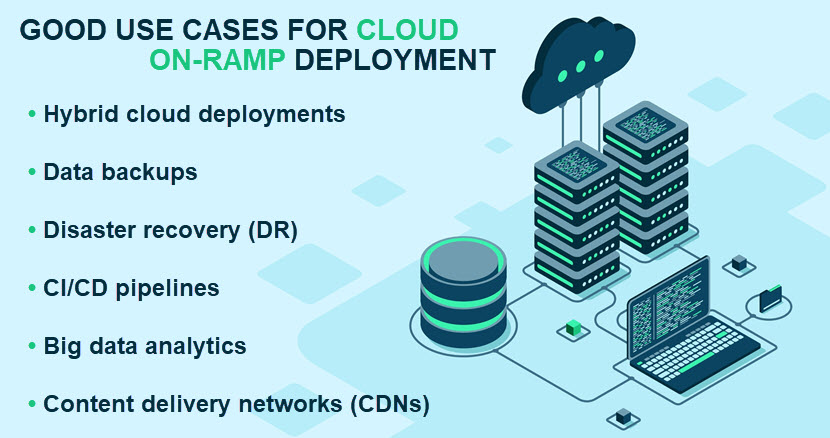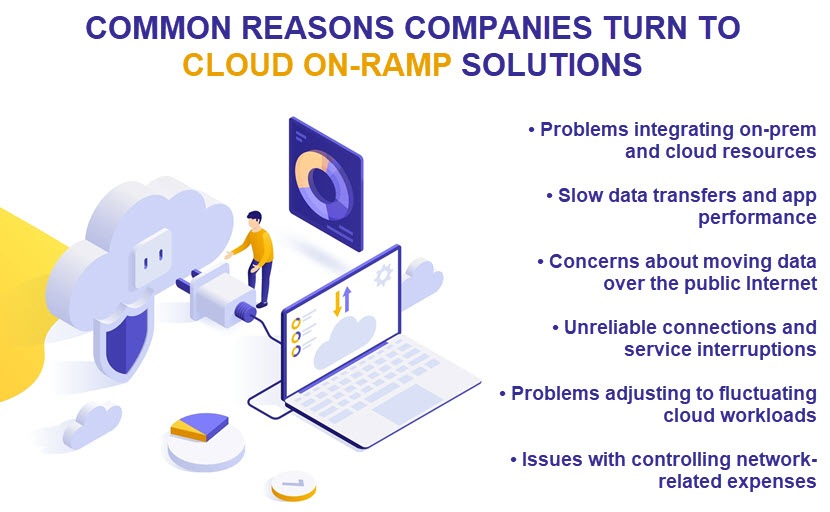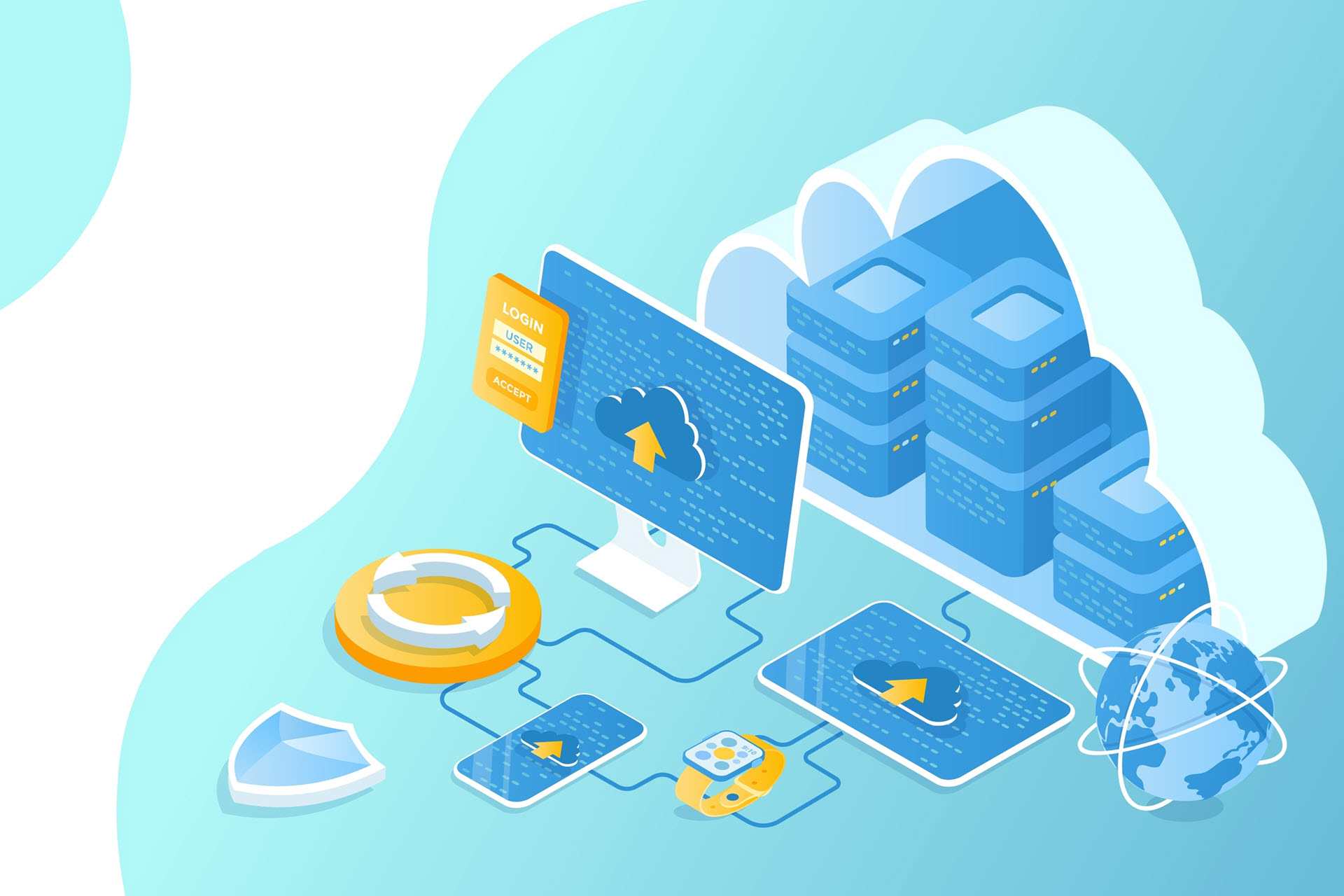Companies that rent or colocate IT equipment at third-party data centers often require direct access to one or more public cloud platforms. Such a connection, called a cloud on-ramp, enables organizations to avoid public Internet networking paths full of performance and security concerns.
Low-latency, direct connections to public clouds are also vital for efficient (and safe) hybrid and multi-cloud deployments.
This article explains everything you need to know about cloud on-ramps and their role in ensuring high-speed cloud computing. Read on to learn how on-ramps enhance the effectiveness of cloud infrastructure and see whether direct public cloud connects are a good fit for your use case.

What Does Cloud On-Ramp Mean?
A cloud on-ramp (also called a cloud connect) is a private, direct connection to a cloud service provider. On-ramps enable organizations to directly connect their data center infrastructure to cloud services without using public Internet networking.
Cloud on-ramps are a data center service offered to customers who rent servers or colocate equipment at the facility. Data centers create a cloud on-ramp for a customer in one of three ways:
- Dedicated private lines to the public cloud provider.
- Virtual Private Networks (VPNs).
- Software-Defined Wide Area Networks (SD-WANs).
Cloud on-ramps are vital for companies that wish to move segments of their IT to the public cloud but keep parts of the infrastructure on-site. Such scenarios commonly occur when a company is:
- Creating a hybrid cloud architecture that integrates on-prem and cloud-based resources.
- Performing a gradual transition to the cloud.
Cloud on-ramps are also crucial for multi-cloud strategies. Connections to multiple cloud providers reduce latency and enhance the performance of apps and workloads that span multiple clouds.
Network optimization is vital for on-ramp design. Careful traffic management and load balancing are a must when distributing workloads.
A cloud on-ramp must be highly scalable since most customers use connects for cloud bursting (applications running primarily on-prem "bursting" into a public cloud when the demand for computing capacity grows too big for on-site resources). On-ramp solutions also require robust security measures to protect data moving in or out of the cloud.
Want to learn about cloud security? Here are a few insightful reads:
- What Is Cloud Security? (Benefits, Challenges, and Best Practices)
- Cloud Storage Security: How Secure Is Cloud Storage?
- Top Cloud Security Risks, Threats, & Concerns
- How to Create a Cloud Security Policy
- Multi-Cloud Security Best Practices
If data security is a concern or roadblock for your cloud adoption, check out pNAP's Data Security Cloud. This cloud-based platform, built in collaboration with Intel and VMware, protects data with strict segmentation controls and advanced threat detection.
Cloud On-Ramp Use Cases
On-ramp deployments make sense for various use cases that benefit from high-speed connections to the public cloud. Below are a few common use cases where an on-ramp is particularly useful.

Hybrid Cloud Deployments
Hybrid clouds combine on-prem (traditional on-site IT or private clouds) and public cloud resources, allowing organizations to harness both environments' benefits. Cloud on-ramps are crucial in connecting and facilitating the seamless operation of hybrid cloud infrastructure.
Here's how an on-ramp benefits a hybrid cloud deployment:
- Cloud on-ramps enable high-speed and safe integration of on-prem systems with public cloud services. This integration ensures that data, apps, and workloads can move back and forth between environments with minimal friction.
- Keeping data safe is among the leading hybrid cloud challenges. Built-in security measures of an on-ramp ensure secure data sharing between on-prem and cloud environments.
- A cloud on-ramp makes it easier to adapt to changes in the hybrid cloud (e.g., moving more workloads to the cloud or repatriating them to the on-prem environment).
- On-ramps optimize costs by using on-prem infrastructure for steady workloads and public cloud resources for "bursty" variable cloud workloads.
One of the primary features of a hybrid cloud is its scalability, and an on-ramp enables the seamless scaling of workloads. If there's a sudden surge in web traffic, an on-ramp instantly allocates extra computing power from the public cloud to handle the increased load. Once the load decreases, the on-ramp instantly scales back cloud resources to optimize costs.
Learn the difference between horizontal and vertical scaling, two distinct strategies for adding more resources to an IT system.
Data Backup and Disaster Recovery
Cloud on-ramps help create effective backup and disaster recovery (BDR) strategies. An on-ramp provides a secure and efficient pathway to store and recover critical data, greatly enhancing the effectiveness of cloud-based BDR.
Here's a more detailed explanation of the role cloud on-ramps play in data backup and disaster recovery:
- An on-ramp allows companies to back up their data to the cloud efficiently, eliminating the need for costly on-prem storage hardware.
- Moving data to the cloud via an on-ramp is significantly cheaper than using standard Internet connections.
- Cloud on-ramps facilitate real or near-real-time data replication to the cloud. There's minimal permanent data loss even if something goes wrong at the primary data center.
- Companies often use cloud on-ramps to automate data backup processes and minimize the risk of data loss due to human error or oversight.
- Having a cloud on-ramp means organizations can scale computing resources in the cloud rapidly. When a disaster occurs, admins quickly provision additional compute capacity to run apps and services in the cloud, maintaining business continuity.
- A cloud on-ramp accelerates the failover to cloud-based processes if the primary data center goes offline.
phoenixNAP offers state-of-the-art (yet highly affordable) backup services and disaster recovery solutions that protect your data, apps, and operations from unplanned incidents.
Continuous Integration and Continuous Deployment (CI/CD)
DevOps teams often use cloud on-ramps to create development and testing environments in the cloud while keeping the production server on-prem. Such a setup accelerates the software development lifecycle (SDLC) and allows for more rapid and reliable releases.
Continuous Integration (CI) involves automatically building, compiling, and testing apps whenever the team commits changes to the version control system. A cloud on-ramp ensures CI processes can quickly access the necessary resources in the cloud (e.g., build servers).
Teams can also use cloud resources (provided through an on-ramp) to run tests, such as unit, integration, or performance testing.
After testing the app in the CI phase, the Continuous Deployment (CD) phase automates deployment. Cloud on-ramps enable efficient deployments of apps and services to on-prem staging and production environments.
Learn about CI/CD and see whether automated builds, tests, and deployments make sense for your use case:
Big Data Analytics
Companies dealing with vast amounts of data often use cloud on-ramps to connect on-prem data storage to cloud-based big data analytics tools. That way, organizations ensure adequate connectivity between on-prem and cloud resources.
Here's a closer look at the role of cloud on-ramps in big data analytics:
- Big data often originates from various sources, so efficiently ingesting this data into the cloud is critical. Cloud on-ramps are the most effective and cost-efficient way to transfer data to the cloud.
- Cloud on-ramps allow organizations to tap into the scalable compute resources of the cloud for data processing. Elastic scaling of computing resources is especially useful for handling large, unpredictable data sets.
- An on-ramp ensures that cloud-based data is easy to access and manage from an on-prem system.
- A cloud on-ramp includes security measures to protect data during transfer into and out of the cloud. This protection is crucial for maintaining the confidentiality and integrity of raw data.
Cloud on-ramps are also useful for creating cloud-based data lakes where companies store and catalog raw data from various sources. Cloud-based lakes centralize data access and simplify analytics.
Content Delivery Networks
Content delivery networks (CDNs) require efficient distribution of digital content (web pages, images, videos, etc.) to end-users. A cloud on-ramp plays a significant role in content delivery by connecting on-prem infrastructure with cloud-based CDNs and other cloud services.
Here's how cloud on-ramps benefit CDNs:
- Cloud on-ramps enable organizations to efficiently distribute content from multiple cloud data centers around the world.
- On-ramps allow organizations to scale content delivery resources quickly and as needed. Users provision additional cloud resources during traffic spikes to handle increased demand.
- On-ramp solutions typically include real-time monitoring and analytics tools that offer insights into content delivery performance.
- Most on-ramps provide Distributed Denial of Service (DDoS) prevention. This precaution is crucial for safeguarding the content delivery infrastructure from attacks aiming to disrupt service availability.
All phoenixNAP servers come with free DDoS protection. Rely on our automated traffic filtering and lightning-fast DDoS mitigation to ensure no one can disrupt or crash your services with bogus traffic.

What Is a Cloud On-Ramp Location?
A cloud on-ramp location is a data center or network interconnection point that provides direct connectivity to cloud service providers. These facilities have low-latency network connections (e.g., dedicated fiber optic lines or direct network links) that enable users to establish direct connections to public clouds.
These locations are typically close to major cloud providers' data centers or network points of presence (PoPs). This proximity minimizes network latency and provides high-speed connections.
Most cloud on-ramp locations offer interconnection services that enable connectivity between multiple providers and other data centers. Common interconnection services include:
- Cross-connects.
- VPNs.
- Direct peering.
Cloud on-ramp facilities are designed with security and redundancy in mind to ensure data privacy and service availability. Standard precautions include advanced physical security measures, backup power systems, and redundant network connections.
Our guide to data center security shows what it takes to keep a top-tier hosting facility safe from both physical and digital threats.
Cloud On-Ramp Requirements
Companies considering a cloud on-ramp should address several requirements to ensure a successful deployment. Here's a quick overview of what you must do before deploying a cloud on-ramp:
- Clearly define the business objectives you aim to achieve with the cloud on-ramp. Understand what KPIs, performance guarantees, support agreements, and uptime commitments you require.
- Know how the on-ramp adoption fits into and impacts your general IT strategy.
- Ensure your IT team has the necessary know-how to configure, manage, and troubleshoot the cloud on-ramp effectively. Also, assess how much help your team will need from the provider for day-to-day on-ramp management.
- Create an efficient data transfer and migration strategy, especially if you plan to move large volumes of data to the cloud.
- Evaluate your current network infrastructure and assess whether it can support the bandwidth and reliability needed for an efficient cloud on-ramp.
- If necessary, upgrade your existing network infrastructure or add new assets to maximize the benefits of direct public cloud access.
- Ensure you have robust security measures to protect data in transit and at rest. Standard go-to precautions include data encryption and identity and access management.
- Understand the cost structure of cloud on-ramps, including data transfer costs, network usage fees, and cloud resource pricing. Create a budget that aligns with your financial resources and implement cloud cost management strategies to control expenses.
- Determine how the cloud on-ramp will integrate with existing on-prem infrastructure, apps, and services. Assess whether there are any potential compatibility issues.
Our article on cloud computing costs explains everything you need to know about cloud-based expenses (different cost models, how providers set prices, common cost-related problems, etc.).
What Are the Main Benefits of Cloud On-Ramps?
Cloud on-ramps significantly benefit organizations seeking to establish connections between on-prem infrastructure and cloud services. Here are the key advantages of adopting a cloud on-ramp:
- Reduced latency. Cloud on-ramp solutions provide low-latency, high-speed connections that minimize delays in data transfers. On-ramps are ideal for real-time apps and use cases that require a boost in overall performance.
- Hybrid cloud enablement. Cloud on-ramp solutions simplify the building and management of effective hybrid cloud environments. Organizations can seamlessly integrate on-prem infrastructure with cloud services.
- Enhanced security. Direct connections and dedicated network links lead to significantly higher security levels than standard internet connections.
- Data transfer efficiency. Cloud on-ramp solutions include data transfer mechanisms for efficient data migration from on-prem systems to the cloud.
- High redundancy and availability. Cloud on-ramp locations require redundancy and high availability measures, which ensure network connections remain reliable even in times of crisis.
- Cost-efficiency. While there are initial setup costs, cloud on-ramp solutions lead to long-term cost savings. These savings come from optimized data transfers, reduced downtime, and improved resource allocation.
Worried about spiraling IT costs, either on or off the cloud? Check out our article on IT cost reduction to see 12 tried-and-tested ways to lower IT expenses.
phoenixNAP Cloud Connects
Our flagship data center in Phoenix is the home to both AWS Direct Connect and Google Cloud Interconnect. These services enable you to connect your on-prem systems to AWS or Google Cloud using a private network link, bypassing the public Internet and granting you the following benefits:
- Higher bandwidth.
- Lower data transfer latency.
- Consistently high network performance.
In addition to direct connects, our data centers enable you to choose from a variety of different carriers. Visit our carriers page to see the list of all the options available at our facilities.
Another service that might interest you is the Megaport Cloud Router (MCR). This managed virtual routing service enables you to establish private connections between different networks or service providers.
MCR streamlines cloud networking and makes intelligent routing decisions on your behalf, ensuring:
- Direct, private, and secure cloud-to-cloud traffic.
- Low-latency data transfers between different services.
- Reduced networking TCO.
The Megaport Cloud Router is ideal for multi-cloud deployments because it enables you to deploy and seamlessly manage private connections between multiple cloud providers. You can also deploy a virtual router close to your cloud on-ramp for low-latency data transfers.

A Critical Enabler (for the Right Use Case)
On-ramps are a vital enabler for businesses that want to maintain their existing infrastructure while also benefiting from the cloud's scalability, agility, and cost-efficiency. Whether a permanent or a temporary connectivity solution, on-ramps should be on every decision-maker's radar as an option when building hybrid or multi-cloud environments.



